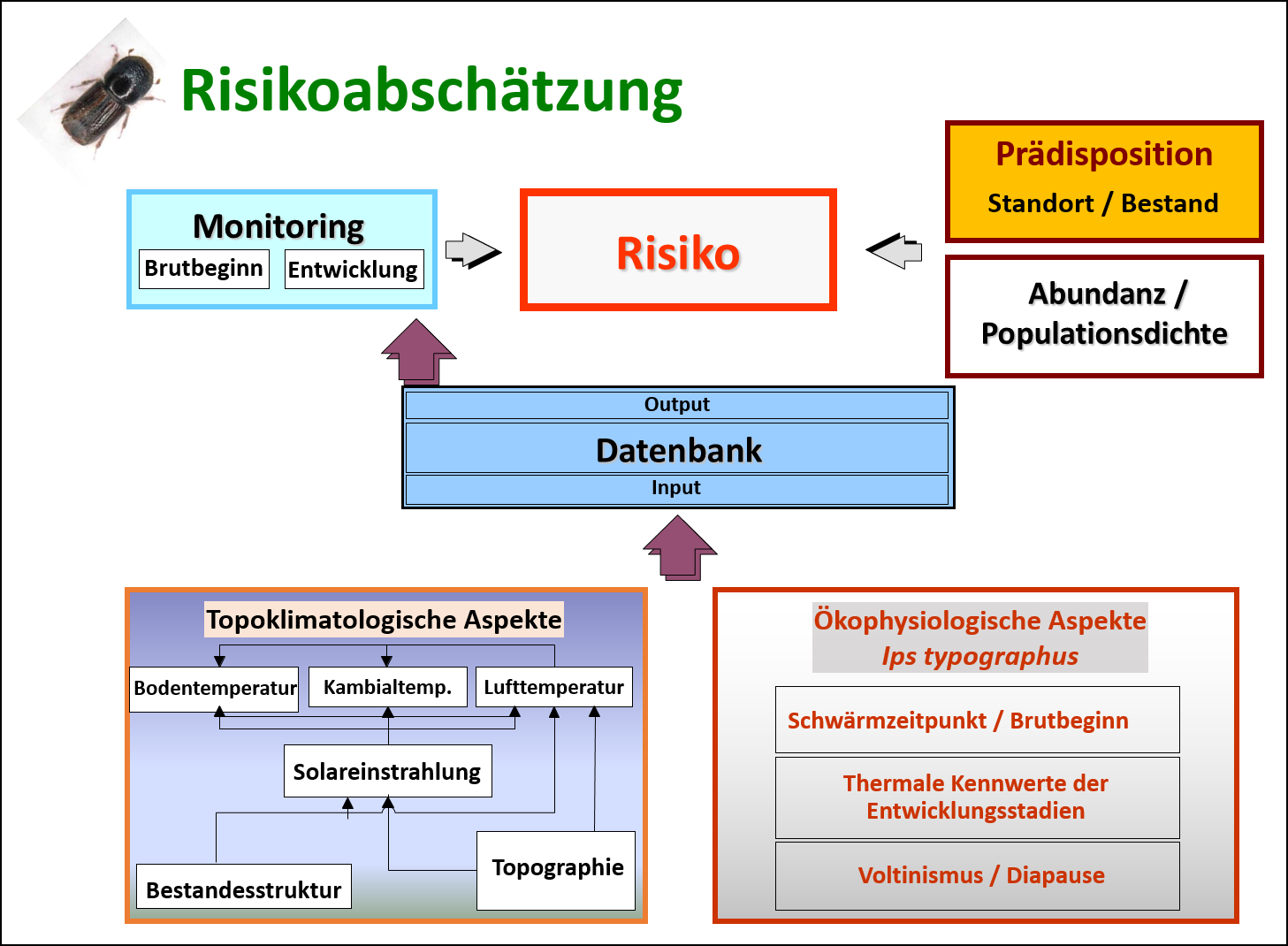Modellierung der Borkenkäfer-Entwicklung mittels PHENIPS
Das Phänologiemodell PHENIPS als Teil der Risikoabschätzung für Borkenkäferbefall
Die Überwachung der Phänologie des Buchdruckers (Schwärmzeiten, Befallsbeginn, Brutentwicklung, potentielle Anzahl an Generationen) ist ein essentieller Bestandteil der Einschätzung des Befallsrisikos von Fichtenbeständen (Abb. 1).
Grundlagen von PHENIPS (Baier et al., 2007)
Mittles PHENIPS ist es möglich, den Schwärm- und Befallsbeginn im Frühjahr, die Entwicklung der Brut, den Beginn von Geschwisterbruten, die Anlage von Folgegenerationen, die Induktion der Diapause und die Überwinterungsfähigkeit der Brut anhand von Klimadaten des Waldstandorts (Abb. 2) zu berechnen.
Die Beziehung zwischen Entwicklungsrate und Temperatur ist nicht für den gesamten Bereich der für den Buchdrucker verwertbaren Temperaturen linear, sondern folgt dem Verlauf einer Optimumskurve. Die Entwicklungsrate steigt bei Temperaturen, die über einen optimalen Temperaturbereich hinausgehen nicht weiter an, sondern verlangsamt sich, und kommt bei Erreichen eines oberen Temperaturschwellenwertes (38,9°C) zum Stillstand (Wermelinger und Seifert, 1998). Anhand dieser nichtlinearen Beziehung kann man die für die Entwicklung relevanten, effektiven Temperaturen (Entwicklungsnullpunkt = 8,3°C) berechnen. Durch Aufsummierung dieser effektiven Temperaturen (Wärmesumme) kann der Brutentwicklungsstand abgeschätzt werden und damit der Zeitpunkt der Entwicklungsvollendung (Schlüpfbeginn der Jungkäfer), aber auch das Auftreten von Geschwisterbruten sowie die Überwinterungsfähigkeit der Brut bestimmt werden.
Anhand der täglich berechneten effektiven Rindentemperatursummen kann die Entwicklung der Bruten und damit die Generationsabfolge des Buchdruckers modelliert werden. Darüber hinaus wird mit dem Modell PHENIPS auch die Schwärmaktivität des Buchdruckers und der Schwärmbeginn bzw. der Befallsbeginn im Frühjahr anhand Schwellenwertes von 16,5°C für das Schwärmen (Lobinger, 1994) und für die Akklimatisierungsphase der überwinternden Käfer (durchschnittliche Temperatursumme von 140 Tagesgrade ab 1. April) abgeschätzt.
Anhand der laufenden Summe der effektiven Rindentemperaturen kann weiters auch der Zeitpunkt des Auftretens von Geschwisterbruten (Schwellenwert: 278,5 Tagesgrade = 50% der Temperatursumme für die Gesamtentwicklung) sowie die Überwinterungsfähigkeit der Brut ermittelt werden. Für eine erfolgreiche Überwinterung muss bis zum Wintereinbruch die Jugendentwicklung (60% der Temperatursumme für die Gesamtentwicklung) abgeschlossen sein, da prä-imaginale Stadien des Buchdruckers einer sehr hohen Wintermortalität unterliegen (Faccoli, 2002). Zur Vermeidung von Verlusten bei zu spät begonnenen Bruten diapausiert der Buchdrucker ab einer Tageslichtlänge < 14,5 Stunden (Dolezal und Sehnal, 2007), d.h., ab Mitte August sind die Käfer nicht mehr brutbereit und es werden in der Regel ab diesem Zeitpunkt keine weiteren Bruten mehr angelegt.
Evaluierung von PHENIPS
PHENIPS wurde im Zuge eines Forschungsprojekts im Nationalpark Kalkalpen entwickelt. Zur Überprüfung der Modellberechnungen anhand der gemessenen Wetterdaten wurde die Flugdynamik und die Brutentwicklung des Buchdruckers mittels beköderter Theysson-Flugbarrierefallen und mittels Fangbaumfichten genau beobachtet und mit dem berechneten Schwärm- bzw. Befallsbeginn sowie mit der simulierten Brutentwicklung verglichen. Die prognostische Qualität des Entwicklungsmodells wurde anhand der Übereinstimmung zwischen dem berechneten und dem beobachteten (am weitesten fortgeschrittenen) Entwicklungsstand bestimmt. Zusätzlich wurden die berechneten Termine für den Beginn von Geschwisterbruten und der zweiten Generation mit den Fallenfängen und dem Beginn des Befalls bei den Fangbäumen der zweiten Fangbaumlegung verglichen (Baier et al., 2007).
Weiters wurde PHENIPS von einer unabhängigen Forschergruppe validiert (Berec et al., 2013) und ist Bestandteil zahlreicher Borkenkäfer-Risikoanlysen (Seidl et al., 2007; Hlasny et al., 2011; Temperli et al., 2013; Pasztor et al., 2013; Mezei et al., 2017).
Online Monitoring der Borkenkäfer-Entwicklung
Das Online Monitoring System bietet die Möglichkeit, die tagesaktuellen Berechnungen und Darstellungen der Buchdruckerentwicklung anhand der fernabgefragten Wetterdaten der jeweiligen Waldklima-Stationen abzufragen. Zu den aggregierten Lufttemperaturmesswerten (Tagesminimum-, mittel, -maximum) wird auch der Zeitpunkt des Schwärmbeginns im Frühjahr sowie sie Anzahl der Schwärmtage ab Schwärmbeginn ausgegeben.
Die berechnete potentielle Generationsentwicklung des Buchdruckers (Minimal- bzw. Maximalentwicklung) wird anhand von Temperatursummenkurven der relativen effektiven Rindentemperaturen getrennt für jede Generation dargestellt (Abb. 3). Die Aufsummierung der effektiven Rindentemperaturen der 1. Generation beginnt mit dem berechneten Zeitpunkt der ersten Hauptschwärmphase des Buchdruckers im Frühjahr.
Literatur
Baier P., Pennerstorfer J. and Schopf A., 2007. PHENIPS—A comprehensive phenology model of Ips typographus (L.) (Col., Scolytinae) as a tool for hazard rating of bark beetle infestation. Forest Ecology and Management, 249(3): 171-186.
Berec L., Doležal P. and Hais M., 2013. Population dynamics of Ips typographus in the Bohemian Forest (Czech Republic): Validation of the phenology model PHENIPS and impacts of climate change. Forest Ecology and Management, 292: 1-9.
Dolezal P., Sehnal,F. 2007. Effects of photoperiod and temperature on the development and diapause of the bark beetle Ips typographus. J.Appl.Entomol. 131: 165 – 173.
Faccoli M., 2002. Winter mortality in sub-corticulous populations of Ips typographus (Col.:Scol.) and its parasitoids in the south-eastern Alps. J. Pest. Sciences, 75: 57-88.
Hlásny T., Zajíčková L., Turčáni M., Holuša J. and Sitková Z., 2011. Geographical variability of spruce bark beetle development under climate change in the Czech Republic. Journal of Forest Science, 57: 242-249.
Lobinger G., 1994. Die Lufttemperatur als limitierender Faktor für die Schwärmaktivität zweier rindenbrütender Borkenkäferarten, Ips typographus L. und Pityogenes chalcographus L. Anz. Schädlingskde.: 14-17.
Mezei P., Jakuš R., Pennerstorfer J., Havašová M., Škvarenina J., Ferenčík J., Slivinský J., Bičárová S., Bilčík D., Blaženec M., Netherer S., 2017. Storms, temperature maxima and the Eurasian spruce bark beetle Ips typographus—An infernal trio in Norway spruce forests of the Central European High Tatra Mountains. Agricultural and Forest Meteorology 242: 85–95.
Pasztor F., Matulla C., Rammer W., Lexer MJ., 2014. Drivers of the bark beetle disturbance regime in Alpine forests in Austria. Forest Ecology and Management 318: 349–358.
Seidl R., Baier P., Rammer W., Schopf A. and Lexer MJ., 2007. Modelling tree mortality by bark beetle infestation in Norway spruce forests. Ecological Modelling, 206(3–4): 383-399.
Temperli C., Bugmann H. and Elkin C., 2013. Cross-scale interactions among bark beetles, climate change, and wind disturbances: a landscape modeling approach. Ecological Monographs, 83(3): 383-402.
Wermelinger B., Seifert M., 1998. Analysis of temperature dependent development of the spruce bark beetle Ips typographus (L.) (Col. Scol.). J. Appl. Ent. 122: 185-191.

Abb. 1: Wichtige Aspekte der Ips typographus – Risikoabschätzung

Abb. 2: Fernabfragbare Waldklimastation für das Phänologiemodell PHENIPS

Abb. 3: Grafische Darstellung der mittels PHENIPS simulierten potentiellen Borkenkäferentwicklung